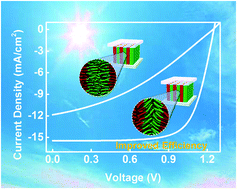Modulation of molecular orientation enabling high photovoltaic performance of block copolymer nanostructures†
Abstract
Block copolymer self-assembly is a promising strategy for high-performance polymer solar cells. However, the power conversion efficiencies of block-copolymer-based solar cells are still not as high as expected. Herein, by means of theoretical simulations we show a distinct improvement in the photovoltaic performance of donor–acceptor block copolymer thin films via regulating the molecular orientation. Self-assembled lamellae perpendicular to electrodes with modulated molecular orientation were obtained by applying electric fields during the block copolymer self-assembly. Our theoretical calculations indicate that compared with the general ones without external field treatment, the power conversion efficiencies of the block copolymer nanostructures with modulated molecular orientation can be improved by more than 150% with high values of short current density and fill factor. The improvement in the photovoltaic performance is ascribed to the simultaneous enhancement in exciton diffusion to donor/acceptor interfaces and charge carrier transport to electrodes. Our findings could yield guidelines for the design of photovoltaic materials with improved photovoltaic performance via control over the molecular orientation.



 Please wait while we load your content...
Please wait while we load your content...